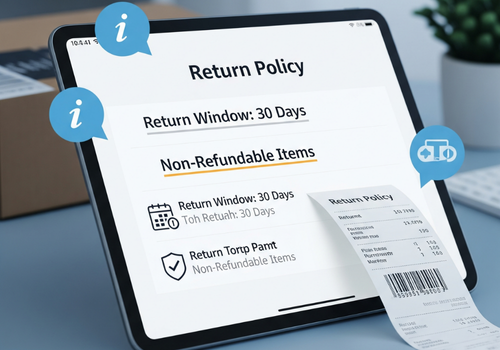Understanding Amazon’s Return Policy and the Hidden Rules Every Smart Online Shopper Should Know Now
The Standard Amazon Return Window: What Most Shoppers Know
Most products sold on Amazon come with a 30-day return window from the date of delivery. That means you can return an item for any reason — whether it’s defective, different from what you expected, or simply not needed anymore. Items fulfilled by Amazon (FBA) usually offer the smoothest return process, with pre-paid return labels and immediate refunds issued once the item is scanned at a drop-off point. Many categories like books, electronics, clothes, and home essentials are eligible under this standard policy. However, what many don’t realize is that the return window may be shorter or longer depending on who sold the item and the specific product type.
Third-Party Sellers on Amazon Have Different Return Policies
Not every item you buy on Amazon is shipped and handled by Amazon itself. In fact, a significant number of listings are fulfilled by third-party sellers who operate under their own set of rules. These sellers are required to follow Amazon’s minimum return guidelines, but they can set stricter policies, such as shorter return periods, requiring items to be unopened, or even charging restocking fees. If you’re buying from a seller directly (not fulfilled by Amazon), always check the “Return Policy” section on the product listing page. In many cases, even if Amazon steps in to help, refunds from third-party sellers can take longer or may require additional approvals.
Non-Returnable Items: What You Can’t Return — Even If You Try
One of the biggest mistakes consumers make is assuming that everything can be returned. In truth, Amazon lists specific categories of items as “non-returnable.” These include personalized products, perishable items, gift cards, live plants, some health and hygiene products, and digital content like eBooks or software downloads. Supplements also fall into this gray area — if the seal is broken or the packaging is tampered with, the return is usually denied due to health safety regulations. To avoid being stuck with a non-returnable item, check the return eligibility before buying. Look for the “Returnable until [date]” label or scroll down to the product details section for seller-defined rules.
Hidden Time Limits and Extended Return Windows You Should Know
While the standard return policy offers 30 days, there are exceptions. Around major holidays like Christmas or Prime Day, Amazon offers extended return windows — sometimes up to 90 days. However, these only apply to certain categories and sellers, and the rules change each year. On the other hand, items bought from Amazon Warehouse Deals or used products may have shorter windows or different refund conditions. Electronics sometimes have separate return periods depending on the brand. If you’re unsure, check your order summary — it will always mention the exact return deadline, which many shoppers ignore until it’s too late.
Refund Timing and How Refunds Are Processed by Amazon
Once you drop off your return and it’s scanned by the courier, Amazon typically processes your refund within 2–3 business days. If the item is returned to Amazon’s own fulfillment centers, the process is faster and more reliable. But when it’s returned to a third-party seller, the refund timing can vary — sometimes up to two weeks. Refunds are issued to the original payment method, but if that method is no longer active, it may result in Amazon gift card credits. For expensive items like electronics, Amazon may wait until the item is inspected before initiating the refund. You can always track refund progress under the “Returns & Orders” section.
Return Shipping Costs: When It’s Free and When It’s Not
Many people assume Amazon pays for all return shipping, but that’s only true for cases where Amazon is at fault — such as defective or incorrect items. If you’re returning something due to personal reasons like “No longer needed” or “Ordered by mistake,” you may be charged for return shipping, which is deducted from your refund. Third-party sellers are more likely to charge for return shipping, even if the item is lightweight. In some cases, Amazon allows you to drop the item at a nearby Amazon Hub Locker or partner location (like Kohl’s or Whole Foods) for free — but again, this depends on the product and your location.
How to Handle Denied Returns and Disputes with Sellers
If your return is denied or the seller refuses to process it, don’t panic — you’re not out of options. First, document everything: tracking number, date of return, seller communication, and screenshots. Then, file a claim under Amazon’s A-to-Z Guarantee, which is designed to protect buyers in situations like this. Amazon will investigate the issue, and if your claim is valid, they will issue a full refund even if the seller disagrees. Be clear and factual when submitting your claim, and use Amazon chat or phone support to speed up the resolution process. This protection is one of the strongest reasons to always shop on Amazon over smaller platforms.
How to Make Returns Easier and Avoid Future Return Problems
There are a few smart practices that can make returns smoother. Always keep the original packaging and shipping label until the return is complete. Print the return label immediately after initiating the return and drop the item off within the time frame — usually 7 days. Take photos of the item before shipping it back, especially for high-value products. Use Amazon drop-off points instead of relying on home pickups, which are more prone to errors. And finally, read seller reviews — if multiple buyers report return issues, it’s a red flag worth avoiding altogether.
Conclusion: Be a Smarter Shopper with a Return Policy Mindset
In today’s fast-paced online shopping world, a smooth return process isn’t just a bonus — it’s a necessity. Amazon’s return policy is generous on the surface, but smart shoppers know that there are hidden rules that can trip you up. By understanding who’s selling your product, checking return eligibility before purchase, keeping an eye on timelines, and using the right tools for support and claims, you’ll avoid return hassles and get your money back faster. In 2025, buyer awareness is the key to better experiences on Amazon — and mastering the return process is one of the most important ways to protect yourself while enjoying the convenience of online shopping.

